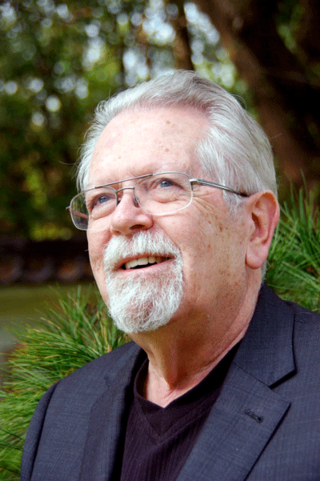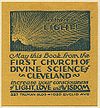
New Age is a range of spiritual or religious practices and beliefs which rapidly grew in Western society during the early 1970s. Its highly eclectic and unsystematic structure makes a precise definition difficult. Although many scholars consider it a religious movement, its adherents typically see it as spiritual or as unifying Mind-Body-Spirit, and rarely use the term New Age themselves. Scholars often call it the New Age movement, although others contest this term and suggest it is better seen as a milieu or zeitgeist.

Christian Science is a set of beliefs and practices which are associated with members of the Church of Christ, Scientist. Adherents are commonly known as Christian Scientists or students of Christian Science, and the church is sometimes informally known as the Christian Science church. It was founded in 1879 in New England by Mary Baker Eddy, who wrote the 1875 book Science and Health with Key to the Scriptures, which outlined the theology of Christian Science. The book became Christian Science's central text, along with the Bible, and by 2001 had sold over nine million copies.

A new religious movement (NRM), also known as alternative spirituality or a new religion, is a religious or spiritual group that has modern origins and is peripheral to its society's dominant religious culture. NRMs can be novel in origin or they can be part of a wider religion, in which case they are distinct from pre-existing denominations. Some NRMs deal with the challenges that the modernizing world poses to them by embracing individualism, while other NRMs deal with them by embracing tightly knit collective means. Scholars have estimated that NRMs number in the tens of thousands worldwide. Most NRMs only have a few members, some of them have thousands of members, and a few of them have more than a million members.
Religion in the United States is widespread and diverse, with the country being far more religious than other wealthy Western nations. An overwhelming majority of Americans believe in a higher power, engage in spiritual practices, and consider themselves religious or spiritual. Christianity is the most widely professed religion, with the majority of Americans being Evangelicals, Mainline Protestants, or Catholics.

Prem Pal Singh Rawat, formerly known as Maharaji, is an Indian international speaker and author. His teachings include a meditation practice he calls "Knowledge", and peace education based on the discovery of personal resources such as inner strength, choice, appreciation and hope.
Hans Rām Singh Rawat, called Shrī Hans Jī Mahārāj and by various other honorifics, was an Indian religious leader.

John Gordon Melton is an American religious scholar who was the founding director of the Institute for the Study of American Religion and is currently the Distinguished Professor of American Religious History with the Institute for Studies of Religion at Baylor University in Waco, Texas where he resides. He is also an ordained minister in the United Methodist Church.
The Divine Light Mission was an organization founded in 1960 by guru Hans Ji Maharaj for his following in northern India. During the 1970s, the DLM gained prominence in the West under the leadership of his fourth and youngest son. Some scholars noted the influence of the Bhagavad Gita and the Radha Soami tradition, a.k.a. Sant Mat movement, but the western movement was widely seen as a new religious movement, a cult, a charismatic religious sect or an alternative religion. DLM officials said the movement represented a church rather than a religion.
The Church of Divine Science is a religious movement within the wider New Thought movement. The group was formalized in San Francisco in the 1880s under Malinda Cramer. "In March 1888 Cramer and her husband Frank chartered the 'Home College of Spiritual Science'. Two months later Cramer changed the name of her school to the 'Home College of Divine Science'." during the dramatic growth of the New Thought Movement in the United States. After the San Francisco earthquake of 1906 and the death of Malinda Cramer, the headquarters moved back to Colorado, establishing its headquarters in Denver, later to move the base of its operations to Pueblo.
The New Thought movement is a new religious movement that coalesced in the United States in the early 19th century. New Thought was seen by its adherents as succeeding "ancient thought", accumulated wisdom and philosophy from a variety of origins, such as Ancient Greek, Roman, Egyptian, Chinese, Taoist, Hindu, and Buddhist cultures and their related belief systems, primarily regarding the interaction among thought, belief, consciousness in the human mind, and the effects of these within and beyond the human mind. Though no direct line of transmission is traceable, many adherents to New Thought in the 19th and 20th centuries claimed to be direct descendants of those systems.
Jewish Science is a Judaic spiritual movement comparable with the New Thought Movement. Many of its members also attend services at conventional synagogues.

Josephine Emma Curtis Hopkins was an American spiritual teacher and leader. She was involved in organizing the New Thought movement and was a theologian, teacher, writer, feminist, mystic, and healer; who taught and ordained hundreds of people, including notably many women. Hopkins was called the "teacher of teachers" and "mother of New Thought" because a number of her students went on to found their own churches or to become prominent in the New Thought Movement, including Charles and Myrtle Fillmore, founders of Unity Church; Ernest Holmes; and H. Emilie Cady, author of Unity's cornerstone text Lessons in Truth. According to Charles S. Braden, Hopkins influenced the development of New Thought "more than any other single teacher", and modern scholars have identified Hopkins as the founder of New Thought.
Sant Mat was a spiritual movement on the Indian subcontinent during the 13th–17th centuries CE. The name literally means "teachings of sants", i.e. mystic Hindu saints. Through association and seeking truth by following sants and their teachings, a movement was formed. Theologically, the teachings are distinguished by inward, loving devotion by the individual soul (atma) to the Divine Principal God (Parmatma). Socially, they are mostly ascetics except few householders. Sant Mat is not to be confused with the 19th-century Radha Soami, also known as contemporary "Sant Mat movement".
Ronald M. Enroth was an American professor of sociology at Westmont College in Santa Barbara, California, and an evangelical Christian author of books concerning what he defined as "cults" and "new religious movements" and important figure in the Christian countercult movement.

Malinda Elliott Cramer was a founder of the Church of Divine Science, a healer, and an important figure in the early New Thought movement.

Nona Lovell Brooks, described as a "prophet of modern mystical Christianity", was a leader in the New Thought movement and a founder of the Church of Divine Science.
The history of New Thought started in the 1830s, with roots in the United States and England. As a spiritual movement with roots in metaphysical beliefs, New Thought has helped guide a variety of social changes throughout the 19th, 20th, and into the 21st centuries. Psychologist and philosopher William James labelled New Thought "the religion of healthy-mindedness" in his study on religion and science, The Varieties of Religious Experience.

The World Vaisnava Association, officially, World Vaisnava Association — Visva Vaisnava Raj Sabha (WVA–VVRS), is an international Gaudiya Vaishnava religious organization, which had been established in 1994 by some Gaudiya leaders for coordination the global mission for glorification the Supreme Lord Krishna. The name of organization refers to the Visva Vaisnava Raj Sabha formed in 1885 by Bhaktivinoda Thakur and to Vaishnavism in whole. Howsoever, de facto, the WVA was founded and includes only Gaudiya Vaishnavas, and barely from splinted branches of the revivalist reformist order of the first half of the 20th century, Gaudiya Math.
Ursula Newell Gestefeld was an American New Thought leader. She founded the Exodus Club which later was renamed the Church of New Thought and College of the Science of Being. Although she had a large following in her lifetime, the organization she founded did not last past her death.









